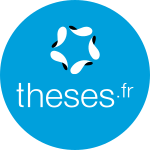Chiral magnetic textures in epitaxial thin films with C2v symmetry
Textures magnétiques chirales en couches minces épitaxiales avec symétrie C2v
Résumé
Chirality is a fascinating property of nature, observed for the first time in 1848 by Louis Pasteur, in the optical response of molecules. More generally, chiral textures often appear in physics as a result of symmetry breaking, either spontaneously, for example in macroscopic quantum systems, or when stabilized by a chiral interaction, as in liquid crystals or magnetism. In magnetism, chirality emerges naturally due to a chiral anti-symmetric exchange interaction called Dzyaloshinskii-Moriya interaction (DMI), in systems with a breaking inversion symmetry and a large spin-orbit coupling. In competition with other magnetic interactions, the DMI promotes chiral non-collinear magnetic textures whose symmetry depends on the crystal symmetry.In this thesis, we study the Aᵤ₁-ₓPtₓ/Co/W(110) stack grown epitaxially on sapphire. substrates, where inversion symmetry is broken and a large spin-orbit-coupling arises due to the large atomic number of the buffer and capping layers. The particularity of the Aᵤ₁-ₓPtₓ/Co/W(110) stack is that it possess a C₂ᵥ symmetry, which results into an anisotropic DMI, with a Néel and a Bloch component, and an uniaxial strain-induced in-plane anisotropy, in addition to the out-of-plane anisotropy promoted by the spin-orbit-coupling.The crystal structure and symmetry of the Aᵤ₁-ₓPtₓ/Co/W(110) stack is investigated by grazing X-ray diffraction and reflection high energy electron diffraction. We found that the C₂ᵥ symmetry is conserved as the Pt content increases, and that the Aᵤ₁-ₓPtₓ/Co/W(110) unit cell lattice parameter follows Vegard's law, decreasing monotonously as the Pt content increases.The evolution of the magnetic parameters as a function of the Au-to-Pt content in the Aᵤ₁-ₓPtₓ/Co/W(110) stack is investigate with Brillouin light scattering in the Damon-Eshbach and the magnetostatic-backward-volume-waves configuration. The interfacial anisotropy is found to follow Vegard's law, decreasing monotonously as the Pt content increases. On the other hand, the N'eel-type DMI is found to increase non-monotonously up to a certain value with the increasing of Pt content, and to decrease above. The in-plane anisotropy energy density is found to remain constant for all the different Pt compositions and to possess a two-fold symmetry. A non-zero Bloch-type DMI is observed using the magnetostatic-backward-volume-waves configuration for Aᵤ₀.₅₈Pt₀.₄₂/Co/W(110) where the anisotropic Néel-type DMI was found to be maximum.The different chiral magnetic configurations that can be stabilized in the magnetic stacks are investigated with X-ray magnetic circular dichroism photoemission electron microscopy (XMCD-PEEM) at the synchrotron ELETTRA (Italy). The energy difference of domain walls (DWs) aligned along the two main in-plane directions depends on the the Au-to-Pt content, as explained by a one-dimensional model and micromagnetic simulations. When the DW energy difference is high, this leads to the stabilisation of self-organised stripe domains or to elliptical magnetic skyrmions. Finally, when approaching the spin-reorientation transition and under specific circumstances, magnetic merons, topologically equivalent to half-skyrmion, are observed in magnetic nanodots.
La chiralité est une propriété fascinante de la nature, qui fut observée pour la première fois par Louis Pasteur en 1848, dans la réponse optique des molécules. En général, des textures chirales apparaissent en physique lorsqu’il y a brisure de symétrie; soit de façon spontanée, comme dans des systèmes quantiques, ou quand stabilisées par une interaction chirale, comme dans les cristaux liquides ou en magnétisme. En magnétisme, la chiralité apparaît naturellement a cause d’une interaction chirale anti-symétrique appelée interaction Dzyaloshinskii-Moriya (DMI) dans des systèmes avec inversion de symétrie et une large interaction spin-orbite. Quand elle est en compétition avec d’autres interactions magnétiques, la DMI favorise la formation de textures chirales non-colinéaires dont la symétrie dépend de la symétrie cristalline. Dans cette thèse, nous étudions des empilements de couches minces de Aᵤ₁-ₓPtₓ/Co/W(110) déposés de façon épitaxiale sur des substrats de safir, dans lesquels la symétrie est brisée et une forte interaction spin-orbite est présente grâce aux atomes lourds composants les couches de buffer et de couverture. Les empilements Aᵤ₁-ₓPtₓ/Co/W(110) possèdent une symétrie C₂ᵥ, qui résulte en une DMI anisotrope, avec une composante Bloch et Néel, aussi bien qu’une anisotropie magnéto-cristallline dans le plan des couches qui s’ajoute à l’anisotropie dans la direction perpendiculaire au plan.La structure cristalline et la symétrie de la multicouche Aᵤ₁-ₓPtₓ/Co/W(110) a été étudiée par diffraction rasante de rayons X et par diffraction d’électrons à haute énergie. Nous avons observé que la symétrie C₂ᵥ est conservée quand la concentration de Pt augmente, et que les paramètres cristallins suivent la loi de Vegard, diminuant de façon monotone avec la concentration de Pt. L’évolution des paramètres magnétiques en fonction de la concentration de Pt dans les multicouches Aᵤ₁-ₓPtₓ/Co/W(110) a été étudié par diffusion de lumière Brillouin dans la géomètrie Damon-Eshbach et dans la configuration dite « magnetostatic-backward-volume-waves ». L’anisotropie d’interface suit la loi de Vegard, diminuant de façon monotone avec la concentration de Pt. La DMI de type Néel augmente de façon non-monotone jusqu’à une certaine concentration de Pt, puis diminue. L’anisotropie dans le plan reste constante pour toutes les concentrations de Pt, et possède une symétrie C₂ᵥ. Une DMI de type Bloch différente de zéro est observée en utilisant la configuration « magnetostatic-backward-volume-waves » dans la multicouche Aᵤ₀.₅₈Pt₀.₄₂/Co/W(110), où la DMI de type Néel a la valeur maximum.Les différentes configurations chirales stabilisées dans les multicouches ont été étudiées par microscopie de photoemission d’électrons associée au dichroisme circulaire magnétique des rayons X (XMCD-PEEM) au synchrotron ELETTRA (Italie). La différence d’énergie de parois de domaines alignées selon les deux directions cristallographiques varie selon la concentration de Pt, comme expliqué par des calculs analytiques 1D et des simulations micromagnétiques. Quand cette différence d’énergie est importante, on observe la stabilisation de domaines auto-organisés et de skyrmions magnétiques. Au voisinage de la réorientation de spin et dans des circonstances particulières, des merons magnétiques, équivalents topologiquement ) à des demi-skyrmions, ont été observés dans des nanostructures magnétiques.
Origine : Version validée par le jury (STAR)


